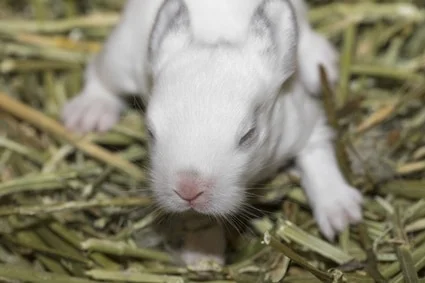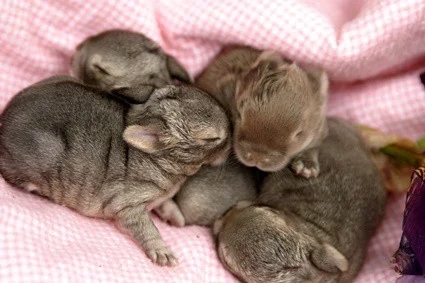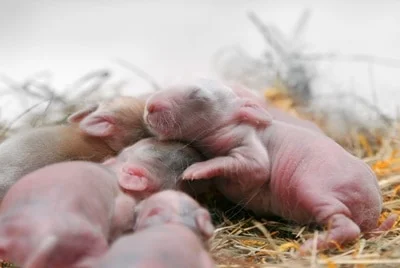Caring for newborn bunny rabbits is no easy task. While mother rabbits take care of their kits, there are instances when human intervention is required. If your bunnies are orphaned or the mother rabbit is sick, you will need to help the kits poop.
Newborn bunnies can’t defecate for themselves until they open their eyes after 7-10 days. Before this time, the mother rabbit stimulates their bellies and anogenital region with her tongue. If the mother rabbit isn’t around, human owners must replicate the process using fingers or a cotton ball. Feces should be firm and round as diarrhea in newborn bunnies can be fatal.
Newborn bunnies are delicate, so exercise caution at all times. It’s important to understand that only 10% of orphaned rabbits survive a week, so seek veterinarian advice before attempting to help the bunny poop.
How Can I Make My Baby Rabbit Poop?
Rabbits produce two types of droppings – fecal pellets and cecotropes. Fecal pellets are the round, dry droppings most commonly found in a rabbit’s litterbox or hutch.
Cecotropes are larger, bunch-like droppings that are produced in the cecum. This is a small pouch located in the junction between the small and large intestines.
The cecum contains bacteria and fungi that provide healthy nutrients that can protect the rabbit from harmful pathogens. To get the healthy bacteria and fungi into the body, rabbits eat the cecotropes soon after they exit the anus.
However, as described by the University of Miami Biology Department, many newborn bunnies can’t defecate or urinate independently. Instead, they rely on their mothers to stimulate their bellies and anogenital region while grooming.
This stimulation helps the newborn bunnies release feces and urine. Afterward, mother rabbits will lick the baby’s fecal matter to remove traces of unsanitary poop.
If your bunny is an orphan, you’ll need to give the animal a helping hand. You can do so by following these steps:
- After feeding, give your hands a thorough clean to remove harmful bacteria.
- Grab a cotton ball and wet it with lukewarm water.
- Lay the bunny gently on its back and support it carefully with your fingers.
- Very lightly rub the bunny’s abdomen and genital area to stimulate elimination.
- Once the bunny defecates, clean it up using a new, clean cotton ball.
- Check that the newborn bunny’s poop is light in color, which is normal and indicates the bunny is healthy.
If you have an adult rabbit at home, you can give the newborn bunny the right nutrients by collecting the adult rabbit’s cecotropes and mixing them with kitten milk replacer.
This will create a formula that keeps the bunny’s intestinal tract healthy. One cecotrope per 3-4 days is enough.
If you can’t get hold of a cecotrope, add a tiny splash of the probiotic acidophilus to the kitten milk formula and feed this to your bunny instead.
How to Prevent Constipation in Bunnies?
Bunnies have sensitive digestion tracts, and the slightest change to their diet can cause constipation. Health problems, like an intestinal blockage or painful teeth, are often to blame. However, stress and anxiety can also throw their digestive system out of balance.
Constipation is a serious health condition in bunnies and must be treated quickly. Symptoms of constipation include:
- Loss of appetite
- Few droppings produced, if any at all
- Swollen stomach
- Hunched posture
- General pain or discomfort
Bunnies are habitual creatures and need plenty of fiber in the diet to maintain a healthy gut. To prevent constipation and keep your bunny pooping properly, try to feed your bunny at the same time each day and ensure it has access to an ample amount of grass hay to graze on throughout the day.
Pellets are fine to eat, but only in small quantities each day. As your bunny begins to grow, start introducing vegetables into its diet.
Leafy greens such as parsley and spinach are fine in moderation, but too much can upset the digestive system and cause either soft stools or constipation. Only feed these kinds of vegetables to your bunny once it is eight weeks old.
Avoid legumes such as beans and peas and starchy foods like bread, pastries, and cereal. These foods offer no nutritional value but cause havoc with your pet’s bowel movements.
If your bunny begins to develop constipation symptoms, restrict the amount of vegetables and pellets you’re offering and monitor your bunny’s bowel movements for any improvements. If there is no improvement, it’s time to see your vet.

When Do Baby Bunnies Poop on Their Own?
Once a baby bunny opens its eyes, you can stop stimulating defecation. This will occur once the bunny is around seven to ten days old.
After a bunny’s eyes have opened, it will begin to urinate and defecate by itself. It can also move on to a diet of hay. The added fiber will produce harder, firmer droppings that are most commonly associated with good health in rabbits.
Keep checking the hutch or pen for signs of bowel troubles, as this period is critical for a bunny’s survival. If you notice any changes to your kit’s stool, seek veterinarian help. Diarrhea, in particular, can be fatal.
What Does Baby Rabbit Poop Look Like?
Baby rabbits begin to eat solid foods when they are between 3 to 4 weeks old. Before this time, their lower intestines are sterile. Afterwards, their intestines are at their most vulnerable as new microorganisms are introduced through solid foods.
Without access to their mother’s milk, bunnies can experience a range of intestinal issues that cause their feces to look and smell irregular. If you notice any of the following fecal issues, it’s time to call a vet.
Stringy Poop
Stringy poop is a sign that your bunny is ingesting too much fur. It’s most common in long-haired bunnies. Though occasionally, fecal matter exits the body looking like a string of pearls.
While your bunny is shedding, stringy poop is normal. However, if you find more than one a week, give your bunny a helping hand by combing its fur to remove the dead strands.
While rare, excess fur can cause furballs, which can become lodged inside your bunny’s stomach or intestinal tract. Rabbits can’t vomit to remove the furballs, so a high fiber diet is essential.
Sticky Poop
Bunnies suffer from what is colloquially known as ‘sticky bottom syndrome.’ This occurs when a bunny’s diet is too high in protein and too low in fiber, producing an excess of soft cecotropes that become caked around its genital region.
Overweight rabbits who cannot reach their bottoms to clean themselves are also at risk. Feces that are stuck to your bunny’s bottom will attract flies and potentially lead to flystrike.
Flystrike is where a fly lays its eggs on the bunny’s bottom, which hatch into maggots that chew into the rabbit’s skin. It’s often fatal and should be treated immediately.
It’s possible to treat the problem by adding more fresh fruits and vegetables into your bunny’s diet while reducing dry food. While the problem persists, bathe your bunny’s bottom in warm, soapy water daily until its poop becomes firm.
Soft Poop
Stools made from poorly formed cecotropes can become too soft, mushy, or runny and stick to a bunny’s anal area. Soft stools are a sign that a bunny’s cecotropes have been retained in the intestines for too long and are excreted in a liquid form that’s impossible for a bunny to consume.
This type of poop is particularly smelly and unpleasant and sticks firmly to a bunny’s fur. Mother rabbits do an excellent job of cleaning their babies’ fur, but orphaned bunnies will need help from a human handler to remove the excess poop.
Introducing more carbohydrates and indigestible fiber to your bunny’s diet can help its feces become more solid.
Green Poop
If your bunny’s poop is bright green or covered in mucus, your bunny may be experiencing GI stasis. According to VCA Hospitals, GI stasis is when the passage of food going through the GI tract slows down.
It’s caused by a change in the population of bacteria living in the GI tract that digest a rabbit’s food. GI stasis most commonly occurs when a rabbit stops eating, which is caused by:
- Dental problems
- Kidney disease
- Stress
- Injury
- Arthritis
- Bacterial, viral, or parasitic infections
- Too much carbohydrate in the diet
- Lack of fiber
Check your bunny’s nest or litterbox for signs of green, foul-smelling feces. A mother rabbit will lick her newborn bunnies clean, so green poop is not always easy to spot.
Diarrhea
The University of Miami Biology Department explains that diarrhea is one of the most common signs of sudden death in baby rabbits. It can appear quickly and kills in a matter of hours. Bunny diarrhea can either be dark brown or a pale yellow color.
Diarrhea in baby rabbits typically occurs because they’ve been weaned from their mothers before they are 8 weeks old, which is far too young.
A bunny needs its mother’s antibiotics and complex organic compounds to keep it healthy. Bunnies also require their mother’s milk from a proper pH environment, which helps to protect their intestines.
After a bunny has been taken away from its mother, there’s a risk that the animal’s human handler could transfer Escherichia coli – a common human intestinal bacteria.
It doesn’t help that owners love to kiss and cuddle their bunnies, which is an easy way to transfer harmful bacteria.
Without proper hygiene measures, the bacteria can be transmitted to the bunny, leading to potentially fatal diarrhea. However, if caught early enough, it can be successfully treated with antibiotics.
My Baby Rabbit Poops Everywhere
Litter training is one of the most challenging aspects of bunny ownership. If your bunny poops everywhere, it’s likely due to poor litter box etiquette. It’s not enough to simply leave a litterbox out for your bunny to use. You need to put effort into the training first.
Don’t be under any illusion – litterbox training takes plenty of patience. Follow these steps to stop your rabbit from defecating everywhere:

Set Up the Litter Tray
Setting up the litter tray is one of the most important steps before you start your training. If it’s not set up correctly, your bunny will defecate in all areas of the home. To get your litter tray sorted, follow these steps:
- Find a litterbox that perfectly suits your bunny’s size. You need to allow for your bunny to grow, so make sure it’s big enough – but not too big that it rattles around.
- Bunnies like to eat while using their tray, so line their litterbox with a generous layer of hay.
- Fill the litterbox with litter that’s safe for your bunny. Paper or wood-based litter is best – avoid cat litters that are dusty or clump together. Pine or cedar litters are also harmful.
- Regularly clean the litter tray to remove foul smells that may put your bunny off using its litter tray.
Once you’ve got your litter tray set up, you’re ready to move onto training.
Litter Train Your Bunny
Litter training can be a long and frustrating process, but you must do it properly to make using the tray as easy as possible for your bunny. Follow these steps:
- Set up the litter tray where your bunny naturally gravitates and show your pet that it’s there.
- Start by keeping your bunny in a confined area where its litter tray lives.
- Every time your rabbit makes a successful trip to the litter tray, reward it with a tasty treat.
- Gradually begin to increase the amount of room your rabbit has access to. If your bunny has an accident, restrict its roaming area for a few days until you see an improvement.
- Leave droppings in your bunny’s litter tray for a couple of days to help it associate the toilet with the litter tray.
- Eventually, your bunny will sit inside its litter tray while doing its business. This is normal, as your bunny likes to munch on hay at the same time.
Once your bunny’s litter tray routine is cracked, you can leave it to roam while safe in the knowledge that it’s unlikely to have an accident.
Unfortunately, it’s very difficult to care for a newborn bunny rabbit. Intestinal problems are common and even the slightest changes to the bunny’s diet can cause havoc with the gut. When helping your newborn bunny to poop, you must be extremely gentle and careful not to press too hard. Doing so may harm the kit’s fragile organs.

